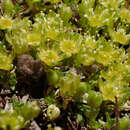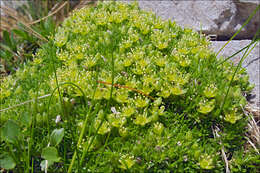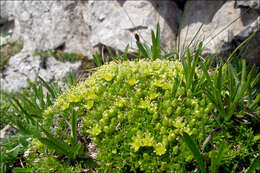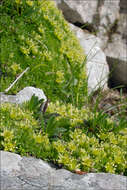-
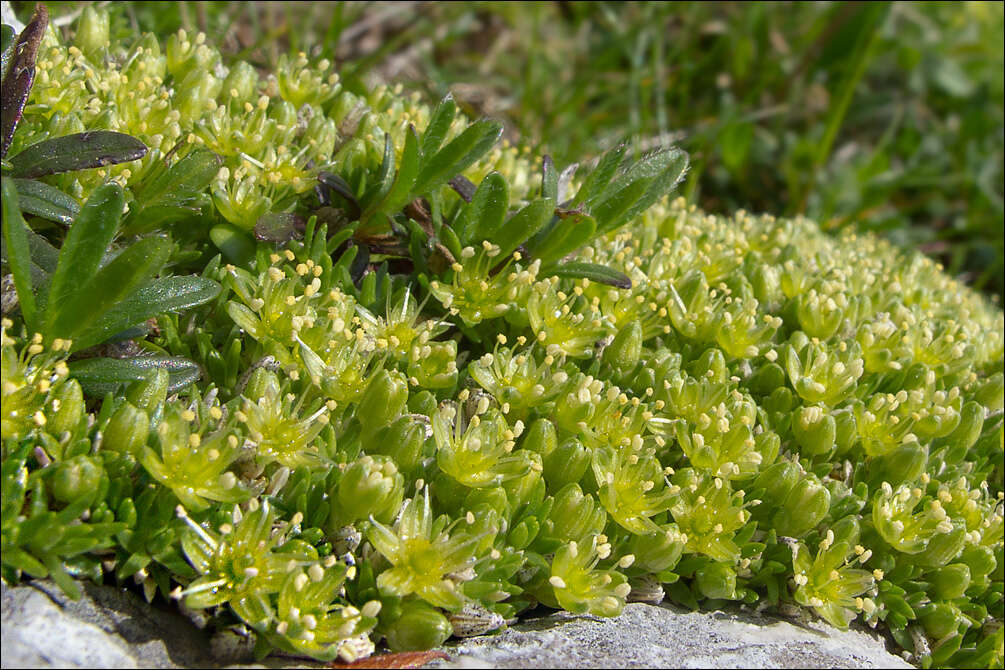
Minuartia sedoides (L.) Hiern, syn.: Cherleria sedoides L., Alsine cherleriCyphal, DE: Zwerg-Miere, Polster-MiereSlo.: homulina rvinkaDat.: June 6. 2015Lat.: 46.43791 Long.: 13.63974Code: Bot_844/2015_IMG8109Habitat: Rock crevices of an almost vertical rock step, south oriented slope; calcareous ground; full sun, exposed to direct rain, elevation 1.870 m (6.130 feet), average precipitations ~ 3.000 mm/year, average temperature 0 - 2 deg C, alpine phytogeographical region. Substratum: soil in rock crevices.Place: Mt. Mangart flats, next to the access road to the mountain cottage 'Koa na Mangartu', East Julian Alps, Posoje, Slovenia EC.Comment: This plant almost always forms very dense, regular and often spherical cushions. In spite of the fact that it is all yellow-green and has no colorful petals, which usually makes plants eye-catching, it is very interesting and nice. Only very seldom petals appear in a form of very tiny, narrow, yellow-green leaflets, which are inconspicuous, even hard to see. From far Minuartia sedoides looks like cushions of bright green moss. Its cushions are easy to spot and remember. It grows in the whole Alps and other European mountains and climbs very high. It generally blooms in July and August. The date of my photographing is unusually early. This is partly because of relatively low elevation of this find and also because of generally early season this year (2015).Ref.:(1) D. Aeschimann, K. Lauber, D.M. Moser, J.P. Theurillat, Flora Alpina, Vol. 1., Haupt (2004), p 284.(2) A. Martini et all., Mala Flora Slovenije, Tehnina Zaloba Slovenije (2007) (in Slovene), p 163. (3) Rothmaler 3, Exkursionsflora von Deutschland, 11. Aufl., Elsevier, Spectrum (2007), p 86. (4) K. Lauber and G. Wagner, Flora Helvetica, 5. Auflage, Haupt (2012), p 622.
-
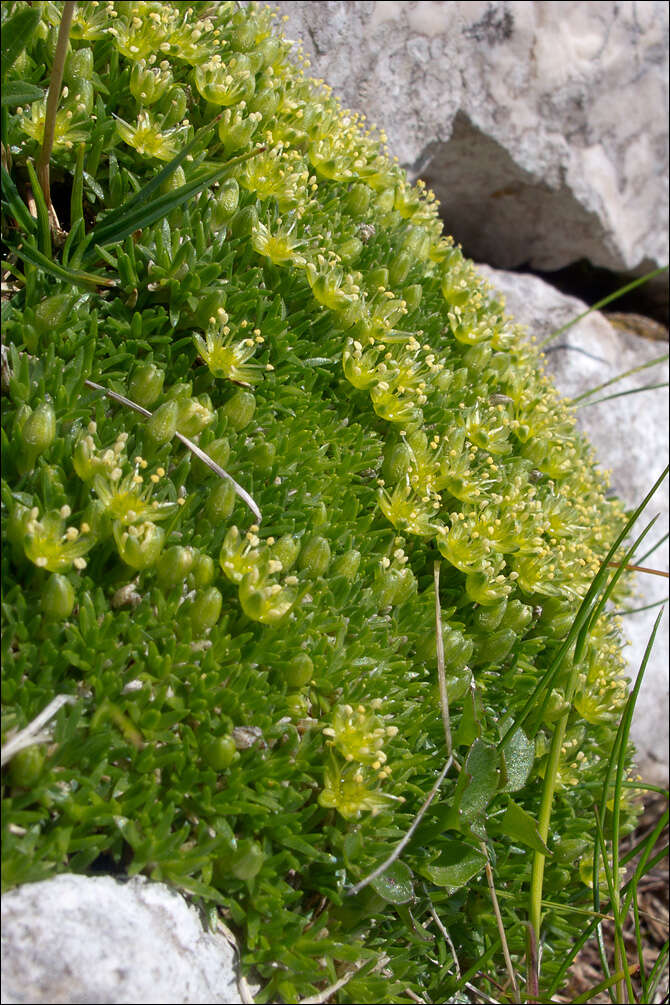
Minuartia sedoides (L.) Hiern, syn.: Cherleria sedoides L., Alsine cherleriCyphal, DE: Zwerg-Miere, Polster-MiereSlo.: homulina rvinkaDat.: June 6. 2015Lat.: 46.43791 Long.: 13.63974Code: Bot_844/2015_IMG8109Habitat: Rock crevices of an almost vertical rock step, south oriented slope; calcareous ground; full sun, exposed to direct rain, elevation 1.870 m (6.130 feet), average precipitations ~ 3.000 mm/year, average temperature 0 - 2 deg C, alpine phytogeographical region. Substratum: soil in rock crevices.Place: Mt. Mangart flats, next to the access road to the mountain cottage 'Koa na Mangartu', East Julian Alps, Posoje, Slovenia EC.Comment: This plant almost always forms very dense, regular and often spherical cushions. In spite of the fact that it is all yellow-green and has no colorful petals, which usually makes plants eye-catching, it is very interesting and nice. Only very seldom petals appear in a form of very tiny, narrow, yellow-green leaflets, which are inconspicuous, even hard to see. From far Minuartia sedoides looks like cushions of bright green moss. Its cushions are easy to spot and remember. It grows in the whole Alps and other European mountains and climbs very high. It generally blooms in July and August. The date of my photographing is unusually early. This is partly because of relatively low elevation of this find and also because of generally early season this year (2015).Ref.:(1) D. Aeschimann, K. Lauber, D.M. Moser, J.P. Theurillat, Flora Alpina, Vol. 1., Haupt (2004), p 284.(2) A. Martini et all., Mala Flora Slovenije, Tehnina Zaloba Slovenije (2007) (in Slovene), p 163. (3) Rothmaler 3, Exkursionsflora von Deutschland, 11. Aufl., Elsevier, Spectrum (2007), p 86. (4) K. Lauber and G. Wagner, Flora Helvetica, 5. Auflage, Haupt (2012), p 622.
-

Minuartia sedoides (L.) Hiern, syn.: Cherleria sedoides L., Alsine cherleriCyphal, DE: Zwerg-Miere, Polster-MiereSlo.: homulina rvinkaDat.: June 6. 2015Lat.: 46.43791 Long.: 13.63974Code: Bot_844/2015_IMG8109Habitat: Rock crevices of an almost vertical rock step, south oriented slope; calcareous ground; full sun, exposed to direct rain, elevation 1.870 m (6.130 feet), average precipitations ~ 3.000 mm/year, average temperature 0 - 2 deg C, alpine phytogeographical region. Substratum: soil in rock crevices.Place: Mt. Mangart flats, next to the access road to the mountain cottage 'Koa na Mangartu', East Julian Alps, Posoje, Slovenia EC.Comment: This plant almost always forms very dense, regular and often spherical cushions. In spite of the fact that it is all yellow-green and has no colorful petals, which usually makes plants eye-catching, it is very interesting and nice. Only very seldom petals appear in a form of very tiny, narrow, yellow-green leaflets, which are inconspicuous, even hard to see. From far Minuartia sedoides looks like cushions of bright green moss. Its cushions are easy to spot and remember. It grows in the whole Alps and other European mountains and climbs very high. It generally blooms in July and August. The date of my photographing is unusually early. This is partly because of relatively low elevation of this find and also because of generally early season this year (2015).Ref.:(1) D. Aeschimann, K. Lauber, D.M. Moser, J.P. Theurillat, Flora Alpina, Vol. 1., Haupt (2004), p 284.(2) A. Martini et all., Mala Flora Slovenije, Tehnina Zaloba Slovenije (2007) (in Slovene), p 163. (3) Rothmaler 3, Exkursionsflora von Deutschland, 11. Aufl., Elsevier, Spectrum (2007), p 86. (4) K. Lauber and G. Wagner, Flora Helvetica, 5. Auflage, Haupt (2012), p 622.
-
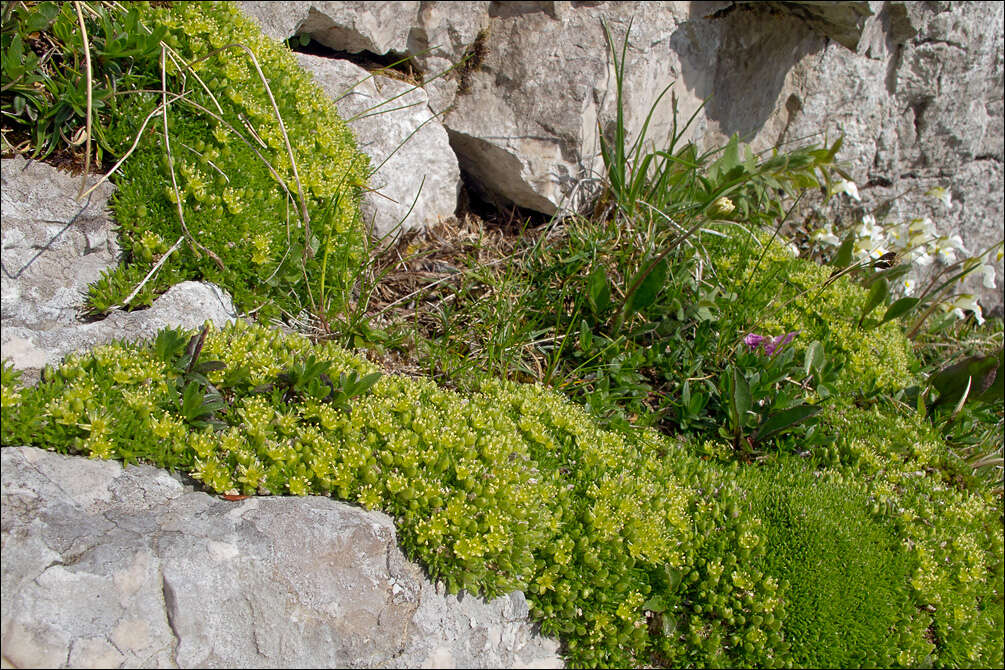
Minuartia sedoides (L.) Hiern, syn.: Cherleria sedoides L., Alsine cherleriCyphal, DE: Zwerg-Miere, Polster-MiereSlo.: homulina rvinkaDat.: June 6. 2015Lat.: 46.43791 Long.: 13.63974Code: Bot_844/2015_IMG8109Habitat: Rock crevices of an almost vertical rock step, south oriented slope; calcareous ground; full sun, exposed to direct rain, elevation 1.870 m (6.130 feet), average precipitations ~ 3.000 mm/year, average temperature 0 - 2 deg C, alpine phytogeographical region. Substratum: soil in rock crevices.Place: Mt. Mangart flats, next to the access road to the mountain cottage 'Koa na Mangartu', East Julian Alps, Posoje, Slovenia EC.Comment: This plant almost always forms very dense, regular and often spherical cushions. In spite of the fact that it is all yellow-green and has no colorful petals, which usually makes plants eye-catching, it is very interesting and nice. Only very seldom petals appear in a form of very tiny, narrow, yellow-green leaflets, which are inconspicuous, even hard to see. From far Minuartia sedoides looks like cushions of bright green moss. Its cushions are easy to spot and remember. It grows in the whole Alps and other European mountains and climbs very high. It generally blooms in July and August. The date of my photographing is unusually early. This is partly because of relatively low elevation of this find and also because of generally early season this year (2015).Ref.:(1) D. Aeschimann, K. Lauber, D.M. Moser, J.P. Theurillat, Flora Alpina, Vol. 1., Haupt (2004), p 284.(2) A. Martini et all., Mala Flora Slovenije, Tehnina Zaloba Slovenije (2007) (in Slovene), p 163. (3) Rothmaler 3, Exkursionsflora von Deutschland, 11. Aufl., Elsevier, Spectrum (2007), p 86. (4) K. Lauber and G. Wagner, Flora Helvetica, 5. Auflage, Haupt (2012), p 622.
-
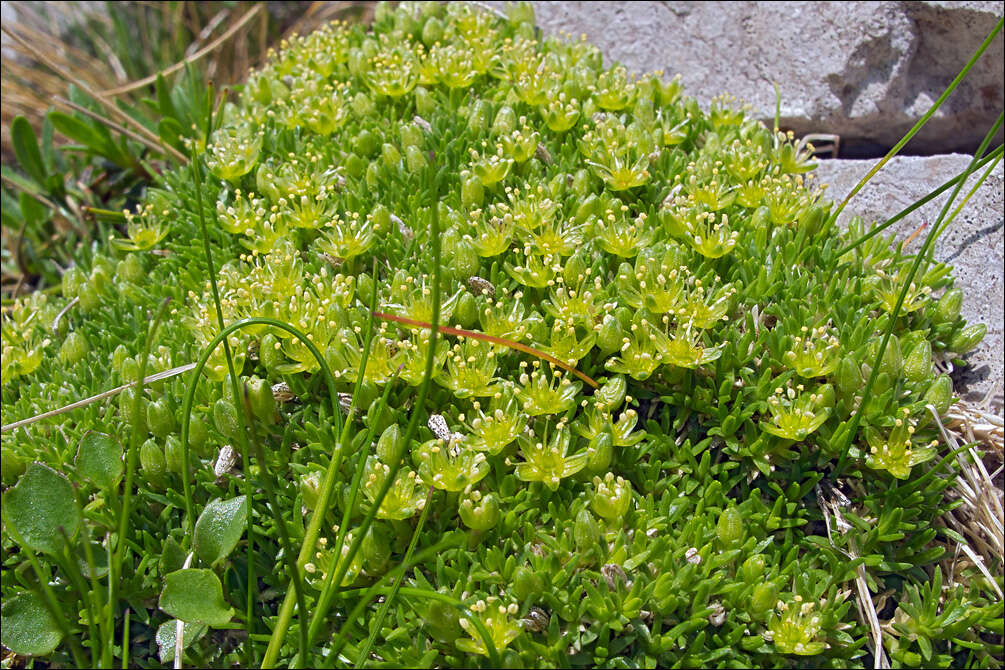
Minuartia sedoides (L.) Hiern, syn.: Cherleria sedoides L., Alsine cherleriCyphal, DE: Zwerg-Miere, Polster-MiereSlo.: homulina rvinkaDat.: June 6. 2015Lat.: 46.43791 Long.: 13.63974Code: Bot_844/2015_IMG8109Habitat: Rock crevices of an almost vertical rock step, south oriented slope; calcareous ground; full sun, exposed to direct rain, elevation 1.870 m (6.130 feet), average precipitations ~ 3.000 mm/year, average temperature 0 - 2 deg C, alpine phytogeographical region. Substratum: soil in rock crevices.Place: Mt. Mangart flats, next to the access road to the mountain cottage 'Koa na Mangartu', East Julian Alps, Posoje, Slovenia EC.Comment: This plant almost always forms very dense, regular and often spherical cushions. In spite of the fact that it is all yellow-green and has no colorful petals, which usually makes plants eye-catching, it is very interesting and nice. Only very seldom petals appear in a form of very tiny, narrow, yellow-green leaflets, which are inconspicuous, even hard to see. From far Minuartia sedoides looks like cushions of bright green moss. Its cushions are easy to spot and remember. It grows in the whole Alps and other European mountains and climbs very high. It generally blooms in July and August. The date of my photographing is unusually early. This is partly because of relatively low elevation of this find and also because of generally early season this year (2015).Ref.:(1) D. Aeschimann, K. Lauber, D.M. Moser, J.P. Theurillat, Flora Alpina, Vol. 1., Haupt (2004), p 284.(2) A. Martini et all., Mala Flora Slovenije, Tehnina Zaloba Slovenije (2007) (in Slovene), p 163. (3) Rothmaler 3, Exkursionsflora von Deutschland, 11. Aufl., Elsevier, Spectrum (2007), p 86. (4) K. Lauber and G. Wagner, Flora Helvetica, 5. Auflage, Haupt (2012), p 622.
-
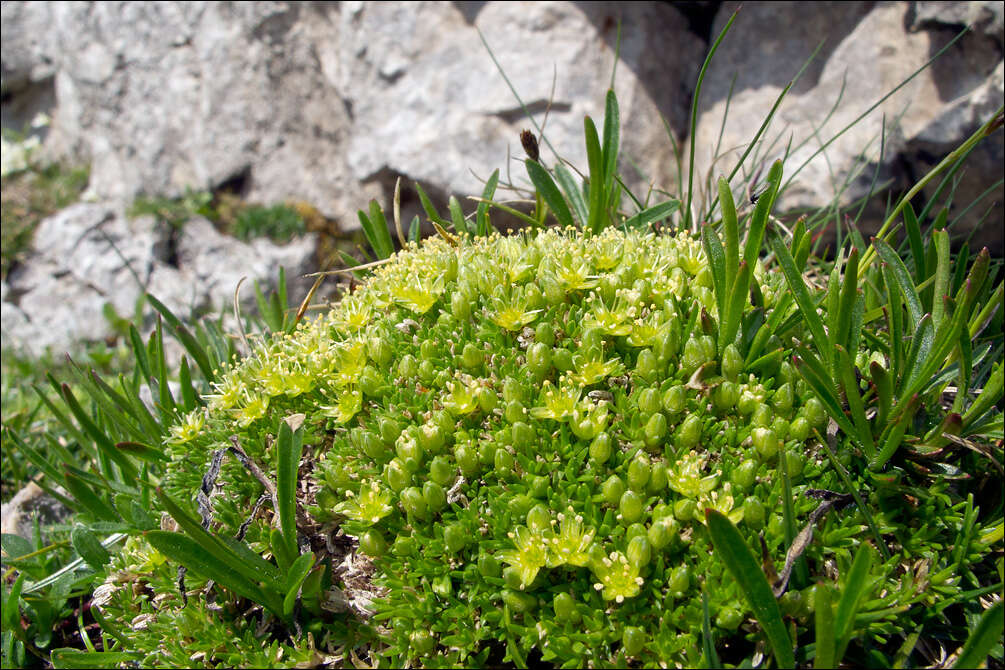
Minuartia sedoides (L.) Hiern, syn.: Cherleria sedoides L., Alsine cherleriCyphal, DE: Zwerg-Miere, Polster-MiereSlo.: homulina rvinkaDat.: June 6. 2015Lat.: 46.43791 Long.: 13.63974Code: Bot_844/2015_IMG8109Habitat: Rock crevices of an almost vertical rock step, south oriented slope; calcareous ground; full sun, exposed to direct rain, elevation 1.870 m (6.130 feet), average precipitations ~ 3.000 mm/year, average temperature 0 - 2 deg C, alpine phytogeographical region. Substratum: soil in rock crevices.Place: Mt. Mangart flats, next to the access road to the mountain cottage 'Koa na Mangartu', East Julian Alps, Posoje, Slovenia EC.Comment: This plant almost always forms very dense, regular and often spherical cushions. In spite of the fact that it is all yellow-green and has no colorful petals, which usually makes plants eye-catching, it is very interesting and nice. Only very seldom petals appear in a form of very tiny, narrow, yellow-green leaflets, which are inconspicuous, even hard to see. From far Minuartia sedoides looks like cushions of bright green moss. Its cushions are easy to spot and remember. It grows in the whole Alps and other European mountains and climbs very high. It generally blooms in July and August. The date of my photographing is unusually early. This is partly because of relatively low elevation of this find and also because of generally early season this year (2015).Ref.:(1) D. Aeschimann, K. Lauber, D.M. Moser, J.P. Theurillat, Flora Alpina, Vol. 1., Haupt (2004), p 284.(2) A. Martini et all., Mala Flora Slovenije, Tehnina Zaloba Slovenije (2007) (in Slovene), p 163. (3) Rothmaler 3, Exkursionsflora von Deutschland, 11. Aufl., Elsevier, Spectrum (2007), p 86. (4) K. Lauber and G. Wagner, Flora Helvetica, 5. Auflage, Haupt (2012), p 622.
-

Minuartia sedoides (L.) Hiern, syn.: Cherleria sedoides L., Alsine cherleriCyphal, DE: Zwerg-Miere, Polster-MiereSlo.: homulina rvinkaDat.: June 6. 2015Lat.: 46.43791 Long.: 13.63974Code: Bot_844/2015_IMG8109Habitat: Rock crevices of an almost vertical rock step, south oriented slope; calcareous ground; full sun, exposed to direct rain, elevation 1.870 m (6.130 feet), average precipitations ~ 3.000 mm/year, average temperature 0 - 2 deg C, alpine phytogeographical region. Substratum: soil in rock crevices.Place: Mt. Mangart flats, next to the access road to the mountain cottage 'Koa na Mangartu', East Julian Alps, Posoje, Slovenia EC.Comment: This plant almost always forms very dense, regular and often spherical cushions. In spite of the fact that it is all yellow-green and has no colorful petals, which usually makes plants eye-catching, it is very interesting and nice. Only very seldom petals appear in a form of very tiny, narrow, yellow-green leaflets, which are inconspicuous, even hard to see. From far Minuartia sedoides looks like cushions of bright green moss. Its cushions are easy to spot and remember. It grows in the whole Alps and other European mountains and climbs very high. It generally blooms in July and August. The date of my photographing is unusually early. This is partly because of relatively low elevation of this find and also because of generally early season this year (2015).Ref.:(1) D. Aeschimann, K. Lauber, D.M. Moser, J.P. Theurillat, Flora Alpina, Vol. 1., Haupt (2004), p 284.(2) A. Martini et all., Mala Flora Slovenije, Tehnina Zaloba Slovenije (2007) (in Slovene), p 163. (3) Rothmaler 3, Exkursionsflora von Deutschland, 11. Aufl., Elsevier, Spectrum (2007), p 86. (4) K. Lauber and G. Wagner, Flora Helvetica, 5. Auflage, Haupt (2012), p 622.

